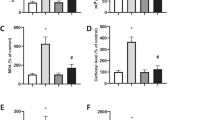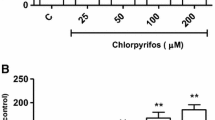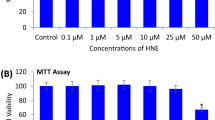Abstract
(1) Morroniside belongs to an extensive group of natural iridorid glycosides. In the present study, using human neuroblastoma SH-SY5Y cells, we have investigated the protective effects of this compound on modifications in endogenous reduced glutathione (GSH), intracellular oxygen species (ROS) and apoptotic death on H2O2-mediated cytoxicity. (2) Incubation of cells with morroniside led to a significant dose-dependent elevation of cellular GSH accompanied by a marked protection against H2O2-mediated toxicity. Morroniside at 1–100 μM inhibited the formation of ROS and the activation of caspase-3 and 9, and the upregulation of Bcl-2, whereas no significant change occurred in Bax levels. (3) The results indicated that the anti-oxidative and anti-apoptotic properties render this natural compound potentially protective against H2O2-induced cytotoxicity. (4) This study suggested that intracellular GSH appeared to be an important factor in morroniside-mediated cytoprotection against H2O2-toxicity in SH-SY5Y cells.








Similar content being viewed by others
References
Ambrosio S, Espino A, Cutillas B, Bartrons R (1996) MPP+ toxicity in rat striatal slices: relationship between non-selective effects and free radical production. Neurochem Res 21:73–78
Andres D, Cascales M (2002) Novel mechanism of Vitamin E protection against cyclosporine A cytotoxicity in cultured rat hepatocytes. Biochem Pharmacol 64:267–276
Andres M, Jose MC, Daniel F, Manuel JD, Jorge S, Herminia D, Maria JN, Carlos JP (2001) Natural antioxidants from residual sources. Food Chem. 72:146–171
Behl C (1999) Alzheimer’s disease and oxidative stress: implications for novel therapeutic approaches. Prog Neurobiol 57:301–323
Bharat S, Cochran BC, Hsu M, Liu J, Ames BN, Andersen JK (2002) Pre-treatment with R-lipoic acid alleviates the effects of GSH depletion in PC12 cells: implications for Parkinson’s disease therapy. Neurotoxicology 23:479–486
Bielder JL, Roffler-Tarlov S, Schachner M, Freedman LS (1978) Mutiple neurotransmitter synthesis by human neuroblastoma cell lines and clones. Cancer Res 38:3751–3757
Chen RW, Chuang DM (1999) Long term lithium treatment suppresses p53 and Bax expression but increases Bcl-2 expression. A prominent role in neuroprotection against excitotoxicity. J Biol Chem 274:6039–6042
Cole GM, Wu K, Timiras P (1985) A culture model for age-related human neurofibrillary pathology. Int J Dev Neurosci 3:23–32
Cutillas B, Espejo M, Ambrosio S (1998) 7-Nitroindazole prevents dopamine depletion caused by low concentrations of MPP+ in rat striatal slices. Neurochem Int 33:35–40
Daniela U, Laura P, Anna C, Daniele B, Pier LC, Maurizio M (2002) Pergolide protects SH-SY5Y cell against neurodegeneration induced by H2O2. Eur J Pharmacol 434:17–20
Das NP, Pereira TA (1990) Effects of flavonoids on thermal autoxidation of palm oil structure-activity relationships. J Am Oil Chemists’ Soc 67:255–258
Deng GM, Su JH, Ivins KJ, Van Houten V, Cotman CW (1999) Bcl-2 facilitates recovery from DNA damage after oxidative stress. Exper Neurol 159:309–318
Duan S, Weng XC, Dong XW (1998) Antioxidant properties of butylated hydroxytoluene refluxed in ferric chloride solution. Food Chem 61:101–105
Farooqui SM (1994) Induction of adenylate cyclase sensitive dopamine D2-receptors in retinoic acid induced differentiated human neuroblastoma SH-SY5Y cells. Life Sci 55:1887–1893
Fiers W, Beyaert R, Declercq W, Vandenabeele P (1999) More than one way to die: apoptosis and necrosis and reactive oxygen damage. Oncogene 18:7719–7730
He Y, Imam SZ, Dong Z, Jankovic J, Ali SF, Appel SH, Le W (2003) Role of nitric oxide in rotenone-induced nigro-striatal injury. J Neurochem 86:1338–1345
Hissin PJ, Hilf R (1976) A fluorometric method for determination of oxidized and reduced glutathione in tissues. Anal Biochem 74:214–226
Hou Q, Cymbalyuk E, Hsu SC, Xu M, Hsu YT (2003) Apoptosis modulatory activities of transiently expressed Bcl-2: roles in cytochrome C release and Bax regulation. Apoptosis 8:617–629
Itano Y, Nomura Y (1995) 1-Methyl-4-phenylpyridinium ion (MPP+) causes DNA fragmentation and increases the Bcl-2 expression in human neuroblastoma, SH-SY5Y cells, through different mechanisms. Brain Res 704:240–245
Jang JH, Surh YJ (2001) Protective effects of resveratrol on hydrogen peroxide-induced apoptosis in rat pheochromocytoma (PC12) cells. Mutation Res 496:181–190
Kaneko T, Baba N, Matsuo M (2003) Protection of coumarins against linoleic acid hydroperoxide-induced cytotoxicity. Chem Biol Interact 142:239–254
Li CY, Li L, Li YH, AI HX, Zhang L (2005) Effects of extract from Cornus officinalis on nitric oxide and NF-κΒ in cortex of cerebral infarction rat model. China J Chinese Mater Med 30:1667–1671
Maria ISR, Irene IP, Maria FMJ, Juana B (2005) Fraxetin prevents rotenone-induced apoptosis by induction of endogenous glutathione in human neuroblastoma cells. Neurosci Res 53:48–56
Molina-Jimenez MF, Sanchez-Reus MI, Benedi J (2003) Effect of fraxetin and myricetin on rotenone-induced cytotoxicity in SH-SY5Y cells: comparison with N-acetylcysteine. Eur J Pharmacol 472:81–87
Molina-Jimenez MF, Sanchez-Reus MI,Andres D, Cascales M, Benedi J (2004) Neuroprotective effect of fraxetin and myricetin against rotenone-induced apoptosis in neuroblastoma cells. Brain Res 1009:9–16
Mosmann T (1983) Rapid colorimetric assay for cellular growth and survival: application to proliferation and cytotoxicity assays. J Immunol Method 65:55–63
Pastorino JG, Chen ST, Tafani M, Snyder JW, Farber JL (1998) The overexpression of Bax produces cell death upon induction of the mitochondrial permeability transition. J Biol Chem 273:7770–7775
Reed JC (1997) Double identity for proteins of the Bcl-2 family. Nature 387:773–776
Saint-Cricq de Gaulejac N, Provost C, Vivas N (1999) Comparative study of polyphenol scavenging activities assessed by different methods. J Agric Food Chem 47:425–431
Sano K, Fujigaki Y, Miyaji T, Ikegaya N, Ohishi K, Yonemura K, Hishida A (2000) Role of apoptosis in uranyl acetate-induced acute renal failure and acquired resistance to uranyl acetate. Kidney Int 57:1560–1570
Satoh I, Sakai N, Enokido Y, Uchiyama Y, Hatanaka H (1996) Free radical independent protection by nerve growth factor and Bcl-2 of PC12 cells from hydrogen peroxide triggered-apoptosis. J Biochem 120:540–546
Seyfried J, Soldner F, Kunz WS, Schulz JB, Klockgether T, Kovar KA, Wullner U (2000) Effect of 1-methyl-4-phenylpyridinium on glutathione in rat pheochromocytoma PC 12 cells. Neurochem Int 36:489–497
Smaili SS, Hsu YT, Sanders KM, Russell JT, Youle RJ (2001) Bax translocation to mitochondria subsequent to a rapid loss of mitochondrial membrane potential. Cell Death Differ 8:909–920
Sonee M, Sum T, Wang C, Mukherjee SK, (2004) The soy isoflavone, genistein, protects human cortical neuronal cells from oxidative stress. Neurotoxicology 25:885–891
Tada-Oikawa S, Hiraku Y, Kawanishi M, Kawanishi S (2003) Mechanism for generation of hydrogen peroxide and change of mitochondrial membrane potential during rotenone-induced apoptosis. Life Sci 73:3277–3288
Wang W, Weng XC, Cheng DL (2000) Antioxidant activities of natural phenolic components from Dalbergia odorifera T. Chen. Food Chem 71:45–49
Weng XC, Wang W (2000) Antioxidant activity of compounds isolated from Salvia plebeian. Food Chem 71:489–493
Yang J, Cheng SQ, Ji CR, Liu YZ (2005) Isolation and structure identification of the chemical constituents from Cornus officinalis. Chinese Trad Herbal Drugs 36:1780–1782
Zhang HY (1999) Theoretical methods used in elucidating activity differences of phenolic antioxidants. J Am Oil Chemists’ Soc 76:745–748
Acknowledgement
This research was supported by the grants from the Program Foundation: Chinese “973” program foundation (2003CB517104); Beijing Natural Science Foundation, China (No: 7062031, 7050001, 7032013); Beijing Science and Technology Committee Program Foundation, China (D0204003000031, D0206001043191); Beijing Superiority Talented Man Foundation, China (No: 2004100501816); Base-Clinical Foundation of Capital Medical University, China (No: 2004JL02, 2006JL09); Key Laboratory for Neurodegenerative Disease Ministry of Education Foundation, China (No:2007).
Author information
Authors and Affiliations
Corresponding author
Rights and permissions
About this article
Cite this article
Wang, W., Huang, W., Li, L. et al. Morroniside Prevents Peroxide-induced Apoptosis by Induction of Endogenous Glutathione in Human Neuroblastoma Cells. Cell Mol Neurobiol 28, 293–305 (2008). https://doi.org/10.1007/s10571-007-9168-7
Received:
Accepted:
Published:
Issue Date:
DOI: https://doi.org/10.1007/s10571-007-9168-7




